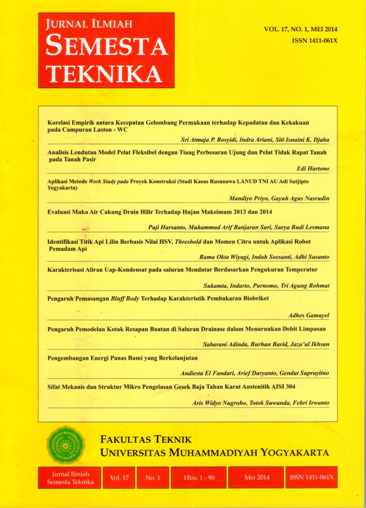Pengaruh Pemasangan Bluff Body Terhadap Karakteristik Pembakaran Biobriket
DOI:
https://doi.org/10.18196/st.v17i1.409Abstract
Biofuels are organic feedstock fuel produced by living organisms, such as solids, liquids, or gases. Biobriket combustion process is affected by the heating value biobriket constituent materials and the amount of air entering the biobriket combustion chamber. The purpose of this study isto determine the effect of variations of the bluff bodygeometry on the biobriket burning process. The independent variable used in this study, arethe fan rotation and the bluff bodygeometry. Fan rotation being used are 1000 rpm, 1200 rpm, 1400 rpm, 1600 rpm, 1800 rpm and 2000 rpm, while the bluff body geometry are round, triangle, square, hexagon and octagon. Triangular cross-section bluff body was noted to produce the highest temperature of 33.21 °C at 100 second. While the lowest temperature wasreached at 500 second with 31.18 oC. Fan rotation at 2000 rpm was found to produce the most rapid combustion,burnt out 10 grams of biobriket within 500 seconds.The conclusion to this study is the higher the fan rotation speed, the faster the combustion process of the biobriket. Triangular bluff body was found the best shape in this study.
Downloads
Published
How to Cite
Issue
Section
License
Semesta Teknika is licensed under a Creative Commons Attribution 4.0 International License.
Authors who publish with this journal agree to the following terms:
- Authors retain copyright and grant the journal right of first publication with the work simultaneously licensed under a Creative Commons Attribution License that allows others to share the work with an acknowledgement of the work's authorship and initial publication in this journal.
- Authors are able to enter into separate, additional contractual arrangements for the non-exclusive distribution of the journal's published version of the work (e.g., post it to an institutional repository or publish it in a book), with an acknowledgement of its initial publication in this journal.
- Authors are permitted and encouraged to post their work online (e.g., in institutional repositories or on their website) prior to and during the submission process, as it can lead to productive exchanges, as well as earlier and greater citation of published work (See The Effect of Open Access).









